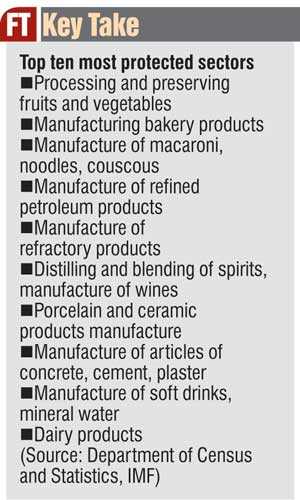Wednesday Nov 06, 2024
FT
Wednesday Nov 06, 2024
Monday, 25 June 2018 00:00 - - {{hitsCtrl.values.hits}}
The International Monetary Fund (IMF), in its latest report on Sri Lanka’s economy, has highlighted protectionism as a key factor in the country’s weak trade competitiveness and remarked on the use of lobbying rather than strategic development or high employment as reasons for being protected.

Sri Lanka’s weakness in trade competitiveness partly stems from its restrictive trade policies. According to trade policy indicators recently developed by the IMF, Sri Lanka’s trade and FDI regimes are more restrictive than the average emerging market in all key areas.
“In particular the country is more distant from the emerging market average in the categories of trade facilitation performance and ease of starting a foreign business. These findings are consistent with those of the World Economic Forum’s Enabling Trade Index 2016, which scores Sri Lanka at 4.1 out of 7 mainly due to market access, tariff rates and tariffs faced in destination markets,” the report said.
The introduction of para-tariffs has significantly increased the degree of protectionism, the IMF added. Introduction of para-tariffs during the last decade has effectively doubled the protection rates, making the present import regime one of the most complex and protectionist in the world. The para-tariffs not only increase monetary costs for firms but also procedural costs. A recent survey by the International Trade Centre finds that the biggest challenges from para-tariffs are a lack of information and extensive documentation as well as delays in processing, which is particularly hard to bear for small firms.
“The most protected segments of the economy benefit from both high tariffs and para-tariffs. In addition, some sub-sectors have a third layer of protection on their inputs through selected tax holidays or exemptions. Consequently, the Effective Rate of Protection (ERP) for the top 10 most protected sectors reaches between 170% and 524% as of 2015.”
“Interestingly, some of the most protected sectors do not necessarily represent strategic development or high employment activities but appear effective in lobbying for protection. Moreover, the increase in the web of protective barriers seems to coincide with the decline in total contribution of State-owned establishments to sectoral value added manufacturing. Furthermore, it appears that the Government gave up direct ownership in some sectors but simultaneously ensured the lasting protection of private companies in those same sectors.”
The report also said that in order to address these challenges as part of the V2025 priorities, the Government announced that it would adopt a time-bound plan to eliminate para-tariffs and conduct a comprehensive renewal of tariffs. The Government has committed to eliminate 1,200 lines of para-tariffs in the 2018 Budget and is developing a three-year plan to fully phase out remaining para-tariffs and developing a time bound plan for convergence to a relatively simplified structure. Streamlining the administrative processes and simplifying the structure of para-tariffs and tariffs will have a beneficial impact on trade.